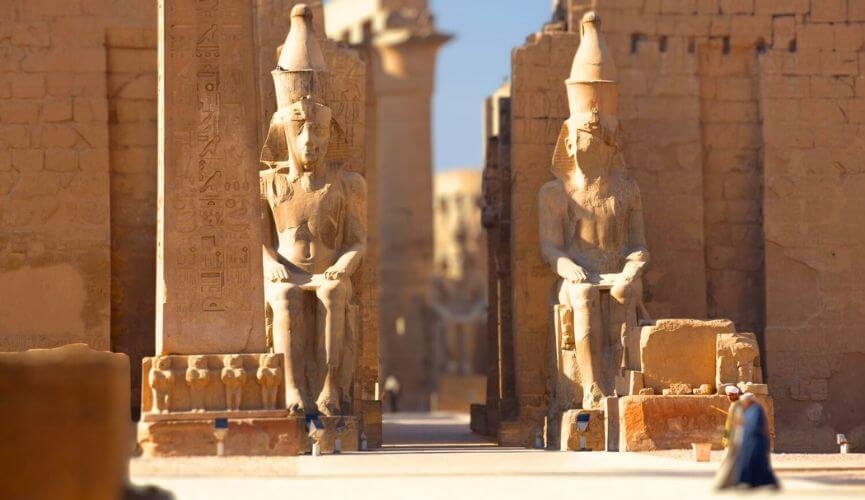Luxor Temple is one of the most important old Egyptian sites and a popular place for tourists worldwide. This temple is an excellent example of building, culture, and history. It is on the east bank of the Nile River in Luxor. The temple is thought to have been built during the rule of Amenhotep III in the 14th century BC. Several kings and pharaohs continued to make changes to it over the years.
In this blog post, we’ll dig deeper into Luxor Temple and look more closely at its rich history, brilliant architecture, and great beauty. We will look closely at the building’s paintings, reliefs, and hieroglyphs, which show a mysterious and wondrous world from the past.
We will also look at the Great Colonnade, the obelisks of Ramses II, and the grand figures of Amenhotep III, all essential parts of the temple grounds. We will look at how each of these statues shows a different part of the temple’s meaning and how they show the ancient Egyptians’ beliefs, culture, and customs.
Through this blog post, we want to give a complete guide to Luxor Temple that will teach tourists and history buffs and make them want to visit this amazing place and feel its magic for themselves. So, come with us as we explore the exciting world of Luxor Temple and discover the old secrets hidden inside its walls.
History of Luxor Temple
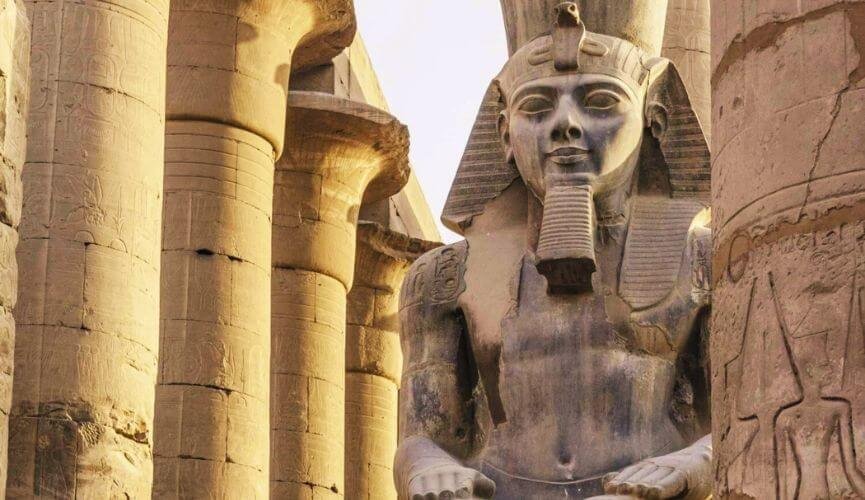
- Luxor Temple is an old Egyptian temple in the city of Luxor. It is one of the most important sites in Egypt and a must-see for tourists. It started in the 14th century BC when Pharaoh Amenhotep III of the 18th dynasty was in charge. He ordered a new temple for the Egyptian god Amun-Ra, the king of all gods.
- Over time, the temple became more extensive and complicated, and several pharaohs, such as Tutankhamun, Horemheb, and Ramesses II, added to it and fixed it up. Each of these kings added something different to the design of the temple. Today, it is a beautiful example of the ancient Egyptians’ craftsmanship and building skills.
- The famous hypostyle hall, built during Amenhotep III, is one of the best parts of Luxor Temple. Every 134 columns in this hall are more than 10 meters tall and have elaborate carvings and hieroglyphs. It is thought to be one of the most impressive pieces of old Egyptian architecture, and it shows how good the country was at art and engineering.
- The halls of Amenhotep III and Ramesses II, the pillar of Tutankhamun, and the shrines of different gods and goddesses are also essential parts of the temple. These buildings combine to make a beautiful temple complex that shows how powerful and wealthy Ancient Egypt was.
- Luxor Temple shows how ancient Egypt had a long and fascinating past and society. It is a great place to visit because it gives people a look into the past and lets them see the unique art, architecture, and building work of one of the most advanced societies in human history.
Architectural Features of Luxor Temple
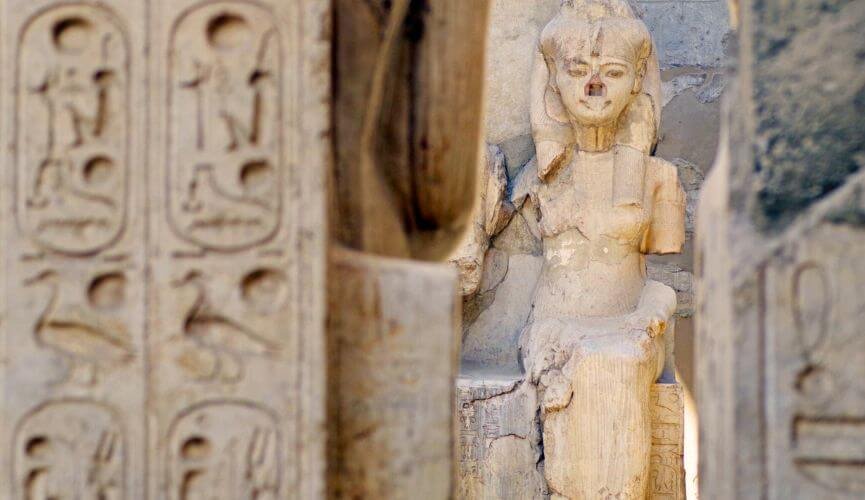
- The great road to the building’s door is one of the most impressive things about the Luxor Temple. The tall sphinxes that line the street give tourists a sense of the temple’s size and importance. The building is ringed by a vast wall that separates the temple from the rest of the world.
- The inside of the temple is just as impressive, with an extensive network of figures and columns. The temple’s towers stand out because they look like colossal lotus flowers, a sign of rebirth to the ancient Egyptians. Each column is elaborately carved with hieroglyphs and other images that show the power and wealth of the pharaohs who built the temple.
- Ancient Egyptians’ religious views and customs were based on how the Luxor Temple was built. The temple was mainly for the Egyptian god Amun, one of the most important gods in their religion. The pharaohs who built the temple thought their closeness to the gods would make them live forever. As a sign of their divine power, they built Luxor Temple.
- In conclusion, the Luxor Temple is a unique and complicated example of an ancient Egyptian building. It has a special form that shows the beliefs and customs of that time. Its size and beauty show how skilled and creative the ancient Egyptians were and how strong their faith in the divine was. Today, Luxor Temple is a reminder of how powerful and smart one of the world’s oldest and most exciting societies was.
Religious Significance of Luxor Temple
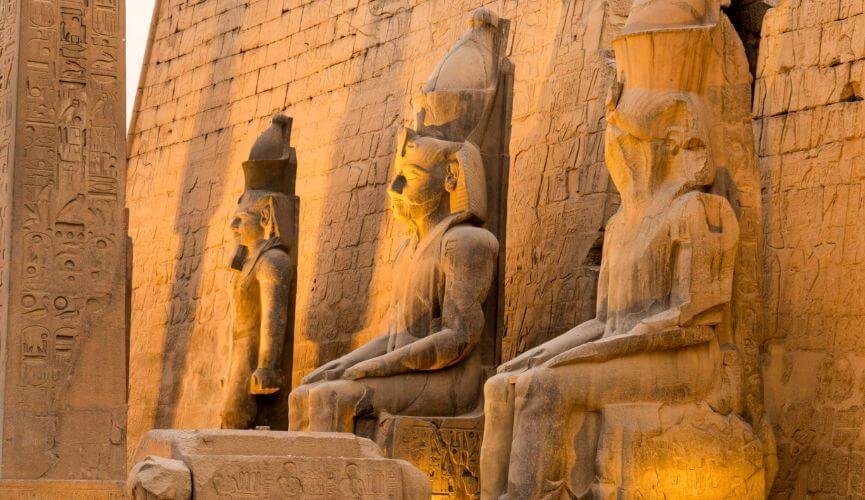
The Luxor Temple is a beautiful example of a holy building from ancient Egypt. During the New Kingdom, the temple was built between 1400 and 1300 BCE. It was where gods and goddesses like Amun, Mut, and Khonsu were worshipped. In ancient Egypt, the temple was the center of sacred life, and people came from all over the land to see it.
- The religious views and behaviors linked to Luxor Temple show its importance. People thought that the gods and goddesses who were honored there lived in the building. People would go to the temple to pray to the gods and make offerings for them, hoping to win their favor. Certain practices had to be done during these trips, like washing and cleansing oneself before entering the temple.
- The Luxor Temple was a place of worship for a very long time. People would pray, make offerings, and celebrate religious holidays at the temple. The temple was also a place where people could learn about the complicated Egyptian faith from teachers. The building was made to look like the whole universe. Its many rooms and shrines represent different parts of the sky.
- There were a lot of gods and goddesses honored at Luxor Temple. One of the most important gods at the temple was Amun, the king of the gods. People thought he made the world and was the god of air and fertility. Mut was the goddess of birth and parenting. She was Amun’s wife. She was usually shown with a vulture on her head. The moon god Khonsu was also an essential god at the temple. He was linked to medicine and recovery, and he was often shown with the head of a hawk.
Ultimately, Luxor Temple was an important religious place in ancient Egypt. It was a place where people went to pray, learn, and enjoy culture. Egyptian folklore and religion had much to do with the gods and goddesses they worshiped. The Luxor Temple is still an important historical and cultural place. People come from all over the world to see it.
Modern-Day Luxor Temple
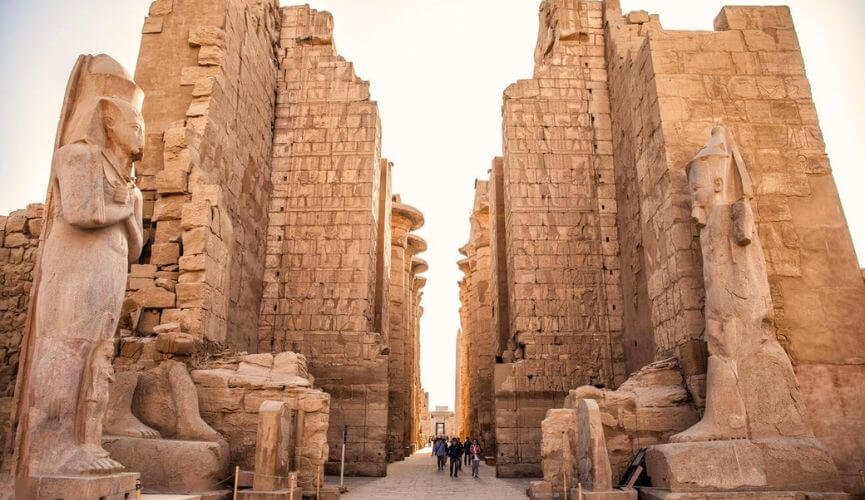
- Keeping the temple’s historical value has become even more critical in recent years. To protect the purity and usefulness of Luxor Temple, the Egyptian government has led several repair and protection efforts in partnership with foreign groups. Much money has been spent on upkeep and repairs, and there have also been efforts to teach people about the temple’s cultural value.
- You can’t say enough about how important Luxor Temple is to culture. It’s the pinnacle of Ancient Egyptian civilization, where history, art, and faith came together in power and grandeur. Today, the temple is a famous tourist place and a source of pride for Egyptians. It is essential to history and culture, which makes it a valuable resource for scholars, researchers, and people who like culture.
- Overall, Luxor Temple is a sign of how the power and beauty of Ancient Egyptian culture have stood the test of time. Its protection, repair, and cultural importance have become essential to Egypt’s ongoing attempts to preserve and promote its rich cultural history. When people visit the temple, they can look at the fantastic artwork and consider what this historical wonder means.
In conclusion, the Luxor Temple is an important reminder of ancient Egyptian culture. It was one of the most impressive buildings of the time because of how it was built and decorated. The temple was also a center of spiritual and pharaonic power, which adds to its religious and political importance.
The trip to Luxor Temple is well worth it, whether you are interested in history or want to see something unique. The temple allows you to learn about the past in a way that not many other places can. The temple’s decorations are stunning in detail and artistry, and it’s interesting to see how the building and design have developed over time.
In addition to its cultural and historical importance, Luxor Temple is also a quiet place to escape modern life’s busyness. Walking through its halls and gardens makes you feel connected to the mystery of ancient Egypt and gives you a sense of peace that is hard to find in our busy world.
In short, Luxor Temple is a true sign of how strong, intelligent, and clever ancient Egypt was. Seeing this fantastic place is a once-in-a-lifetime opportunity, and anyone interested in history, art, or the wonder of the human spirit should go.
Egypt is a country that is steeped in history, culture, and ancient wonders. Whether you are a history buff, an adventure seeker, or simply looking for a relaxing getaway, Egypt has something for everyone. With a wide range of Egypt vacation packages, Egypt day tours, and Egypt Nile cruises, you can explore the best of this fascinating country in style and comfort. From the iconic pyramids of Giza to the bustling streets of Cairo, the tranquil waters of the Nile, to the vibrant markets of Luxor, there is no shortage of things to see and do in Egypt. So why book your Egypt vacation today and experience the magic of this incredible destination for yourself?

